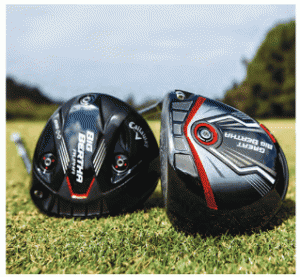 By Mark Harman, USGTF Course Director, Ridgeland, South Carolina
By Mark Harman, USGTF Course Director, Ridgeland, South Carolina
“Distance is ruining the game!” cry the purists.“All it is on tour is driver/wedge, driver/wedge every hole! Why, back in the day, pros were actually hitting long irons into par-4s!”
It’s helpful if we compare “back in the day” with the modern game in terms of driving distance. The PGA Tour began compiling various statistics in 1980, one of them being driving distance. Comparing the first three years of 1980-82 – when almost everyone used a persimmon driver and a balata ball – to the most recent three years (2015-17), we see that the median driving distance increased from 258 yards to 291, a gain of 33 yards. Some of that is due to the golf ball, some due to the driver, and some due to the stronger athletes now playing the pro game.
I decided to test the one aspect of this that I could, the golf club. At my disposal were my current driver, a 45-inch 10.5° Callaway Big Bertha Alpha 815, a 44-inch 9° Callaway Big Bertha Warbird from the early 1990s, and a 43-inch Wilson 4300 persimmon driver, given to me courtesy of USGTF examiner and good friend Mike Levine. Both Callaways have graphite shafts, while the Wilson has the original steel shaft that came with it. All clubs are standard length for their time, except for my current driver, which I cut down ½”.
Over the course of two different sessions on two different days, I hit 12 shots with each driver each session, resulting in 24 shots with each driver. I used a Callaway Chrome Soft ball, and for measurement purposes, an indoor simulator using the GC Quad from Foresight Sports.
I eliminated the shortest 12 shots for each driver, to better measure the solid strikes as my goal was to measure the technology differences in regard to distance. I suppose using the overall averages could give a window into the forgiveness factor for each driver, but that’s another discussion.
A quick note for those of you familiar with Trackman numbers: The “smash factor” (ball speed divided by the clubhead speed) is lower than what is obtained with TrackMan. Why this is, I’m not exactly sure, but in doing some research and some comparisons, it appears TrackMan measures clubhead speed a little lower and ball speed a little higher than GC Quad.
The distance results are what you would expect: The modern titanium driver is longer than the 1990s-era steel driver, which is longer than the1980s-era persimmon driver. The distance results, at least in this simulation, are linear. In terms of clubhead speed, the longer modern driver is the fastest, while the shorter and heavier persimmon wood is the slowest – again, what you would expect.
What I didn’t necessarily expect was the smash factor for the Wilson persimmon driver was higher than the Warbird’s, and almost on a par with the Alpha 815’s. (For the record, I have tested my driver against the newer 2018 models and find no differences in terms of ball speed, spin rate and carry distance.) I remember reading advertisements and articles from the late 1980s and early 1990s claiming persimmon drivers went farther than the then-newsteel drivers, and this gives credence to that claim.
When we further examine the data, we can see that launch angle and backspin play a significant role in distance, as well as the obvious ball speed number. This is why the Warbird, with higher launch and lower backspin, provides more distance than the Wilson. Had I been able to launch the Wilson higher (which was tough given its low loft), I might have been able to match the Warbird’s distance.
Another unexpected development was the backspin rates of the older models. The Warbird had by far the lowest number, while the Wilson and Alpha 815 were virtually identical. As for the Warbird, a club that I used for six years, the original RCH 90 stock shaft splintered from so much use, and in its place is a ProForce XL, a turn-of-the-century shaft featuring a very stiff tip, so that may have had something to do with the low backspin rate.
Because of USGA limits on driver and ball technology, it’s highly unlikely, if not impossible from a physics standpoint, for equipment to provide any more distance gains in the future. Predictions of “everyone” at the tour level being able to hit the ball 400 yards, or even 350, appear to be greatly exaggerated. While long-drive competitors can attain those distances, they do so by making an extremely aggressive swing that is simply not built for competitive golf, rendering them too inaccurate. I suppose one day someone may be able to figure out a way to keep their 350-yard drives in play often enough to compete, but I doubt it. Currently, former long-drive champ Jamie Sadlowski is making a go of it in the professional competitive ranks, but so far he has yet to achieve any notable success. Dennis Paulson, winner of the 1985 long drive championship, did make it to the PGA Tour and in fact won an event in 2000, but he dialed back his distance significantly in order to do so.
In conclusion, I don’t believe the sky is falling in terms of excessive distance ruining the professional game. Instead, let’s marvel at these players’ skill and ability, and keep in mind that the element of human competition is the most important factor in making golf as compelling as it is at the highest level.

Copyright © 2023 United States Golf Teachers Federation, All Rights Reserved
200 S. Indian River Drive, Suite #206, Fort Pierce, FL 34950
772-88-USGTF or 772-595-6490 - www.usgtf.com
200 S. Indian River Drive, Suite #206, Fort Pierce, FL 34950
772-88-USGTF or 772-595-6490 - www.usgtf.com
